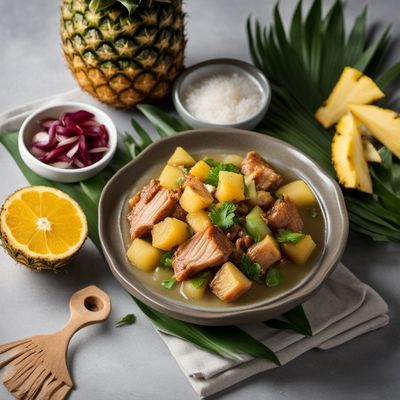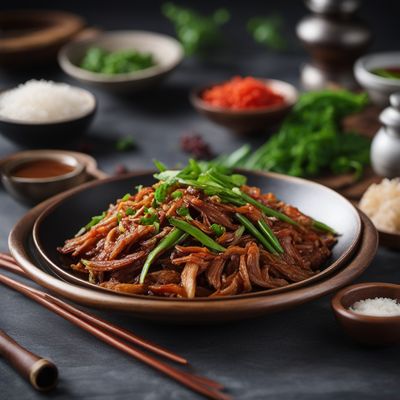
Ingredient
Cooked pork tongue
A Delicacy Worth Exploring
Cooked pork tongue has a tender and slightly chewy texture, with a rich and savory flavor. It is often described as being similar to other cuts of pork, but with a unique melt-in-your-mouth quality. When properly cooked, pork tongue becomes tender and can be easily sliced or shredded.
Origins and history
The consumption of pork tongue dates back centuries and is prevalent in many cultures around the world. It is commonly used in traditional dishes such as tacos de lengua in Mexican cuisine, as well as in European and Asian cuisines. Pork tongue is highly regarded for its versatility and ability to absorb flavors from various seasonings and cooking methods.
Nutritional information
Cooked pork tongue is a good source of protein, iron, and vitamin B12. It is also relatively low in fat compared to other cuts of pork.
Allergens
Cooked pork tongue may not be suitable for individuals with pork allergies or those following specific dietary restrictions. It is important to check for any known allergies or dietary concerns before consuming pork tongue.
How to select
When selecting cooked pork tongue, look for pieces that are moist, tender, and free from any off-putting odors. The color should be pinkish and uniform throughout. If purchasing from a deli or butcher, ask for recommendations on the best quality and preparation methods.
Storage recommendations
To maintain the freshness and quality of cooked pork tongue, store it in an airtight container in the refrigerator. It can be kept for up to 3-4 days. If freezing, wrap the cooked pork tongue tightly in plastic wrap or place it in a freezer-safe bag. It can be stored in the freezer for up to 3 months.
How to produce
Producing cooked pork tongue requires specialized knowledge and equipment. It is recommended to purchase cooked pork tongue from reputable sources or visit local restaurants that specialize in traditional dishes featuring pork tongue.
Preparation tips
Cooked pork tongue can be enjoyed in various ways, including sliced and served cold in sandwiches or salads, or heated and incorporated into hot dishes such as tacos, stews, or stir-fries. It can also be used as a filling for dumplings or added to soups for added richness and flavor.
Culinary uses
Cooked pork tongue is commonly used in dishes such as tacos de lengua (tongue tacos), lengua estofada (braised tongue), and lengua en salsa (tongue in sauce). It is a popular ingredient in Mexican, European, and Asian cuisines, where it is valued for its unique texture and flavor.
Availability
Cooked pork tongue is commonly available in countries with a strong culinary tradition of using offal meats, such as Mexico, Spain, Italy, China, and Japan.
More ingredients from this category

Spalla cotta
The Slow-Cooked Delicacy: Spalla Cotta Unveiled

Corned pork meat, cooked
Savory Delights: Exploring the World of Cooked Corned Pork Meat

Porchetta
"The Italian Delight: Porchetta - A Savory Roasted Pork Delicacy"

Cooked pork ham
"Succulent Slices: Unveiling the Delights of Cooked Pork Ham"

Pastrami, pork
The Savory Delight: Unveiling the World of Pork Pastrami
Recipes using Cooked pork tongue » Browse all

Crispy Pata with a Twist
Golden Crispy Pata: A Filipino Delight Reinvented

Morusa Delight
Savory Delights from the Adriatic: Morusa Delight

Sichuan-style Spicy Eggs Benedict
Fiery Eggs Benedict with a Sichuan Twist

Ginataang Baboy with Pineapple Chunks
Pineapple-infused Creamy Pork Stew: Ginataang Baboy with a Twist

Sakata Ramen with a Twist
Umami Explosion: A Modern Twist on Sakata Ramen

Brazilian Gumbo
Feijoada de Gumbo: A Brazilian Twist on a Classic American Dish

Corsican Stuffed Pork Tenderloin
Savory Delight: Corsican Stuffed Pork Tenderloin

Crispy Pork and Tofu Delight
Crispy Pork and Tofu Delight: A Flavorful Filipino Delicacy

Malaysian Chinese-style Serobe
Spicy and Savory Serobe with a Malaysian Twist

St. Louis-Style BBQ Ribs
Smoky and Tangy St. Louis-Style BBQ Ribs

Turkmen-Style Barbecue Ribs
Sizzling Turkmen Delight: Succulent Barbecue Ribs with a Spicy Twist

Sichuan-style Spicy Ramen
Fiery Noodle Bowl: Sichuan-inspired Spicy Ramen